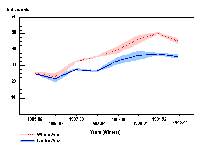 |
Last Update:
Thursday November 22, 2018
|
| [Home] |
|
Volume 10 Pages 1 - 56 (October 1994) Citation: Sulkava, R. (1994) The Otter (Lutra lutra) in Central Finland . IUCN Otter Spec. Group Bull. 10: 27 - 28 The Otter (Lutra lutra) in Central Finland Risto Sulkava Lampilantie 8, Fin - 42800 Haapamäki, Finland
The otter population on the upper tributaries of the Kokemäenjoki-river system was carefully surveyed by snow-tracking in 1985 - 1993. The study area was about 2800 km2. The home range, activity, reproduction and food of otters were studied at the same time. Results of the short surveys were compared with the known number of otters in the area. The otter population in the study area increased in the last eight years (Figure 1). In 1985 there were about 25, and 1993 about 40 otters, and now the otter population is rather dense. From 3 to 5 litters are born per year in the area with 1-3 cubs in each of them. All otters appear to be born in summer. The otters travel in their large home range all year round. The signal activity of otters varies seasonally and scent marking intensity is highest in autumn. Traffic (cars), fish traps and fish hatcheries caused the most of otter deaths.
The short snow-tracking method gives a good picture of the distribution of otters. It also gives some information of the number of otters in the study area. This kind of winter study provides the same information as the standard-survey method ini summer, but far less work is needed in winter. The diet of otters consists mostly (63%) of small fish (10 - 15 cm in length). The diet varies seasonally, in winter frogs (Rana sp. and Bufo bufo) are very important food items (33%), especially in small streams, where most otters live in winter. |
| [Copyright © 2006 - 2050 IUCN/SSC OSG] | [Home] | [Contact Us] |
